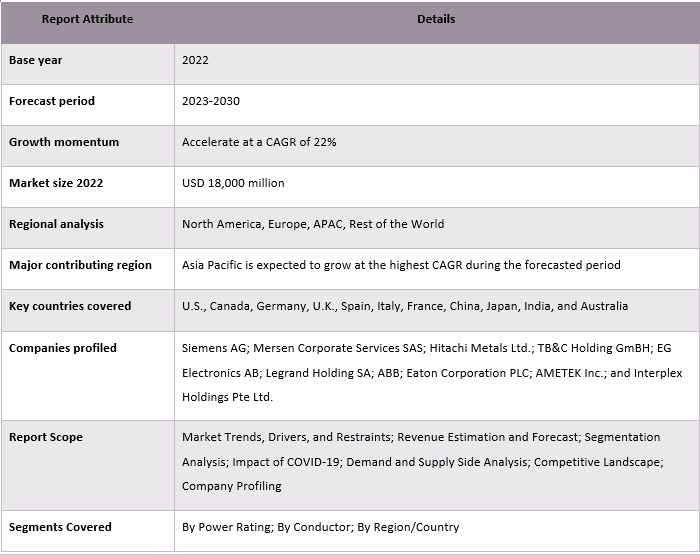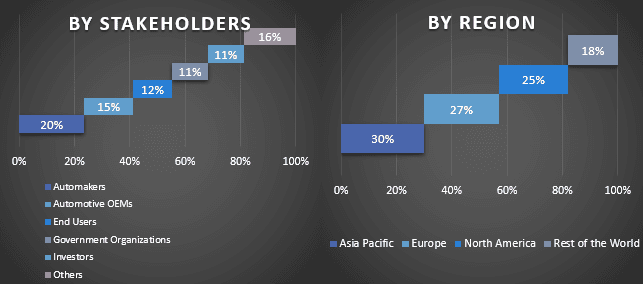- Home
- About Us
- Industry
- Services
- Reading
- Contact Us
Automotive Busbar Market: Current Analysis and Forecast (2023-2030)
Emphasis on Power Rating (Low and High), and Conductor (Copper and Aluminum), Region/Country.

Automotive Busbar Market was valued at USD 18,000 million in 2022 & is expected to grow at a CAGR of 22% from 2023-2030. Busbars are important electrical components used in automobiles, particularly in the vehicle’s electrical and electronic systems. They are used for conducting and distributing electrical power within the vehicle’s electrical system. Some common applications of include busbars being used to connect the vehicle’s battery to the rest of the electrical system, including the starter motor and other electrical components. Furthermore, they are employed to distribute electrical power from the battery to various subsystems and components like lights, motors, and electronics. Moreover, they are commonly used in power electronics modules like inverters and converters for efficient power transfer. Additionally, In electric vehicles, busbars are used in the electric drivetrain to manage high currents between the battery pack, motor, and power electronics. Aluminum and copper busbars play a crucial role in ensuring efficient and reliable power distribution in modern automobiles. They help maintain electrical connections, reduce power losses, and handle high currents without overheating, which is essential for the vehicle’s electrical performance and overall reliability. Several factors contribute to the growing demand for aluminum and copper busbars in automobiles such as the increasing adoption of electric and hybrid vehicles requires efficient power management and high-current handling capabilities, which drive the demand for automotive busbars in these vehicles. Furthermore, Modern vehicles are equipped with advanced electronic systems, including infotainment, driver assistance, and safety features. These systems demand reliable power distribution, leading to the use of busbars.
Some of the major players operating in the market include Siemens AG; Mersen Corporate Services SAS; Hitachi Metals Ltd.; TB&C Holding GmBH; EG Electronics AB; Legrand Holding SA; ABB; Eaton Corporation PLC; AMETEK Inc.; and Interplex Holdings Pte Ltd.
Insights Presented in the Report
Based on power rating, the market is bifurcated into low and high. The low-power automotive busbars are anticipated to witness significant CAGR during the forecast period since increasing vehicle electrification where huge amounts of electric and electronics parts are getting installed in the vehicles of today time with advanced and smart features, where low-power busbars are made from lightweight materials and designed to occupy minimal space helping in reducing vehicle weight and optimize space utilization. Furthermore, low-power rating busbars are more efficient in transmitting power within the specified range and are high in demand in electric and hybrid vehicles where energy efficiency is crucial for extending the driving range and minimizing power losses.
Based on the conductor, the market is bifurcated into copper and aluminum. Copper busbars hold a significant share of the market in the automobile industry. The primary reason for this domination is, in automotive applications, copper busbars are preferred for electrical systems that require high conductivity, such as power distribution and grounding. Furthermore, Copper busbars can carry higher current loads compared to aluminum busbars of the same size. This characteristic is crucial in applications where the busbars need to handle heavy electrical currents, such as in high-powered vehicles or electric vehicles (EVs). Moreover, copper busbars have higher mechanical strength and durability compared to aluminum, making them more resistant to mechanical stresses and vibrations experienced in automotive environments. And due to factors as such copper busbars continue to dominate the demand in the automobile industry, especially in applications where electrical performance is of utmost importance and are gradually becoming the backbone of the growing EV industry as well due to the increased use of electrical and electronic components in the vehicles.
“Asia Pacific is anticipated to witness significant growth in the Automotive Busbar market during the forecasted period.”
For a better understanding of the market adoption of Automotive Busbar, the market is analyzed based on its worldwide presence in the countries such as North America (U.S., Canada, and the Rest of North America), Europe (Germany, U.K., France, Spain, Italy, Rest of Europe), Asia-Pacific (China, India, Japan, Australia, Rest of Asia-Pacific), Rest of World. The automotive busbar market in the Asia Pacific region is anticipated to witness significant growth throughout the forecast period. Owing to the rising per capita GDP of the countries in the Asia Pacific hence improving the standard of living and increasing money in the hands of people driving the consumption of the countries. Furthermore, the rising demand of electric vehicles in the APAC region is also providing the next leg of growth in the demand for the automotive busbars, though as a percentage of total vehicles sold electric vehicle percentage is highest in Europe but the number of units sold in China is leading the pack and has emerged as a top producer and seller of electric vehicles in the world. The Asian countries are projected to produce almost 13 million electric vehicles in the year 2023, whereas, in 2022, china has sold roughly 52% of the total EVs produced in the world which amounts to almost 3.5 million units, India the number is currently at one-third of a million unit but was almost 168% growth from the previous year. Hence, looking at the size of the market that these emerging economies have, the size of the population with rising income and awareness and the availability of the OEMs that are offering great value buys to the customers in terms of price and product and further support from the governments is showing a future of high growth prospects for the electric vehicles market in the APAC region. For instance, China (from a previous 2020 expiration date) extended its NEV subsidy program through the end of 2022, albeit it has started to reduce basic subsidy amounts by 10%, 20%, and 30% per year. (between 2020 and 2022). Through the end of 2023, it also extended the exemption from purchase taxes for NEVs.
Automotive Busbar Market Report Coverage

Reasons to buy this report:
- The study includes market sizing and forecasting analysis validated by authenticated key industry experts.
- The report presents a quick review of overall industry performance at one glance.
- The report covers an in-depth analysis of prominent industry peers with a primary focus on key business financials, product portfolios, expansion strategies, and recent developments.
- Detailed examination of drivers, restraints, key trends, and opportunities prevailing in the industry.
- The study comprehensively covers the market across different segments.
- Deep dive regional level analysis of the industry.
Customization Options:
The global Automotive Busbar market can further be customized as per the requirement or any other market segment. Besides this, UMI understands that you may have your own business needs, hence feel free to connect with us to get a report that completely suits your requirements.
Table of Content
Research Methodology for the Automotive Busbar Market Analysis (2023-2030)
Analyzing the historical market, estimating the current market, and forecasting the future market of the global Automotive Busbar market were the three major steps undertaken to create and analyze the adoption of automotive Busbar in major regions globally. Exhaustive secondary research was conducted to collect the historical market numbers and estimate the current market size. Secondly, to validate these insights, numerous findings and assumptions were taken into consideration. Moreover, exhaustive primary interviews were also conducted, with industry experts across the value chain of the global Automotive Busbar market. Post assumption and validation of market numbers through primary interviews, we employed a top-down/bottom-up approach to forecasting the complete market size. Thereafter, market breakdown and data triangulation methods were adopted to estimate and analyze the market size of segments and sub-segments of the industry pertains to. Detailed methodology is explained below:
Analysis of Historical Market Size
Step 1: In-Depth Study of Secondary Sources:
Detail secondary study was conducted to obtain the historical market size of the Automotive Busbar market through company internal sources such as annual reports & financial statements, performance presentations, press releases, etc., and external sources including journals, news & articles, government publications, competitor publications, sector reports, third-party database, and other credible publications.
Step 2: Market Segmentation:
After obtaining the historical market size of the Automotive Busbar market, we conducted a detailed secondary analysis to gather historical market insights and share for different segments & sub-segments for major regions. Major segments are included in the report as power rating and by the conductor. Further country-level analyses were conducted to evaluate the overall adoption of testing models in that region.
Step 3: Factor Analysis:
After acquiring the historical market size of different segments and sub-segments, we conducted a detailed factor analysis to estimate the current market size of the Automotive Busbar market. Further, we conducted factor analysis using dependent and independent variables such as power rating and by the conductor of the Automotive Busbar market. A thorough analysis was conducted for demand and supply-side scenarios considering top partnerships, mergers and acquisitions, business expansion, and product launches in the Automotive Busbar market sector across the globe.
Current Market Size Estimate & Forecast
Current Market Sizing: Based on actionable insights from the above 3 steps, we arrived at the current market size, key players in the global Automotive Busbar market, and market shares of the segments. All the required percentage shares split and market breakdowns were determined using the above-mentioned secondary approach and were verified through primary interviews.
Estimation & Forecasting: For market estimation and forecast, weights were assigned to different factors including drivers & trends, restraints, and opportunities available for the stakeholders. After analyzing these factors, relevant forecasting techniques i.e., the top-down/bottom-up approach were applied to arrive at the market forecast for 2030 for different segments and sub-segments across the major markets globally. The research methodology adopted to estimate the market size encompasses:
- The industry’s market size, in terms of revenue (USD) and the adoption rate of the Automotive Busbar market across the major markets domestically
- All percentage shares, splits, and breakdowns of market segments and sub-segments
- Key players in the global Automotive Busbar market in terms of products offered. Also, the growth strategies adopted by these players to compete in the fast-growing market
Split of Primary Participants in Different Regions

Market Engineering
The data triangulation technique was employed to complete the overall market estimation and to arrive at precise statistical numbers for each segment and sub-segment of the global Automotive Busbar market. data was split into several segments & sub-segments post studying various parameters and trends in the areas of the additives used, capacity, application, and end-user industry in the global Automotive Busbar market.
The main objective of the Global Automotive Busbar Market Study
The current & future market trends of the global Automotive Busbar market were pinpointed in the study. Investors can gain strategic insights to base their discretion for investments on the qualitative and quantitative analysis performed in the study. Current and future market trends determined the overall attractiveness of the market at a regional level, providing a platform for the industrial participant to exploit the untapped market to benefit from a first-mover advantage. Other quantitative goals of the studies include:
- Analyze the current and forecast market size of the Automotive Busbar market in terms of value (USD). Also, analyze the current and forecast market size of different segments and sub-segments
- Segments in the study include areas of the power rating and by the conductor.
- Define and analysis of the regulatory framework for the Automotive Busbar market
- Analyze the value chain involved with the presence of various intermediaries, along with analyzing customer and competitor behaviors of the industry
- Analyze the current and forecast market size of the Automotive Busbar market for the major region
- Major countries of regions studied in the report include Asia Pacific, Europe, North America, and the Rest of the World
- Company profiles of the Automotive Busbar market and the growth strategies adopted by the market players to sustain in the fast-growing market
- Deep dive regional level analysis of the industry
Related Reports
Customers who bought this item also bought










